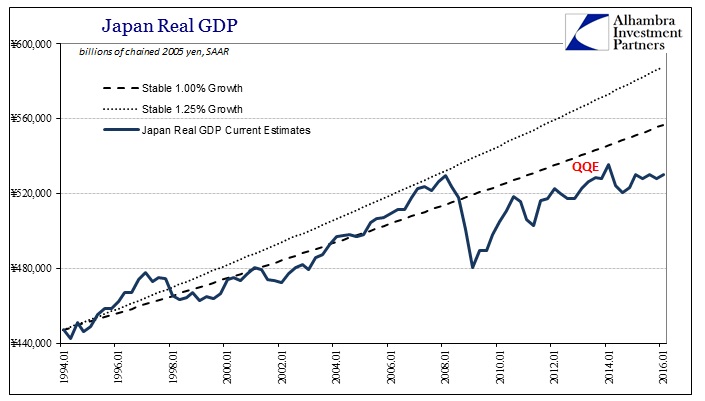So thoroughly destroyed is Japan’s economy that some of the numbers it produces are beyond comprehension, just staggering in any meaningful context. For example, Japan’s real GDP (SAAR) for Q1 2016 was ¥530 trillion (chained 2005). That compared to ¥447 trillion in Q1 1994. Over two decades and two additional years the Japanese economy has grown by a grand total of 18.5%. On straight arithmetic alone it doesn’t work out to 1% per year let alone on a compounded basis.
Since the first quarter of 2001, meaning fifteen years, real GDP “advanced” 10.4% total. Clearly the Japanese economy as bad as it was has slowed from even that revolting baseline. We don’t have to venture far or try too hard to guess when this new “slowing” occurred: since the first quarter of 2008, Japanese GDP thanks to Q1’s positive number is now the slightest amount more than eight years ago (¥530.01 trillion now vs. ¥529.63 trillion, or +0.1%). As everywhere else around the world, the Great Recession was not only a global event, it “somehow” broke the global economy in chillingly uniform fashion.

There is something quite sinister contained within this review, particularly since I haven’t presented the Japanese economy much of any baseline at all. It is fashionable especially of late to believe this is all some trick of slowing demographics and therefore all “stimulus” is to some degree helpless in the face of Japan’s determined self-extinction. There is some truth to the charge, which is the same of any good lie, but it doesn’t amount to a 1% baseline. Capitalism is not strictly population; in fact, that is the true hidden genius and value of capitalism as it creates productive, sustained societal gain well above any demographic shifts. At 1% and less over nearly a quarter century we can safely assume there has been no capitalism practiced in Japan during that time.














Leave A Comment